After visiting the primary school we gained a bit more of an insight of what features we would like to include within our app. Sketching out ideas of what features the app would have and what they would entail, we decided to focus on one specific feature of our app that seemed to be a strong point when visiting the school. Secret dens were talked about a lot and we think this feature would make our app unique and feel we have a lot to work with. Sketching out further detail and features of this one specific topic, sketching the app as a walk through and how the children would use it.
Category: Ideas and Inspirations
Week 6 Log – Sketching – NUTC
Log Week 6
Sketching
This week we began to pull all of our ideas together into sketches and a final storyboard for our choice of project. We had a range of ideas between us, all inspired by our previous research into cycling projects in the past/present.
Our ideas
Some of our ideas were the likes of using barometers to collect data of cyclists going by, animated signposts in which a thumbs up/down could be registered by the sign to see if people were to find it interesting or not, resulting in either more facts on the post or a link to a website/ twitter page in which people can leave positive feedback. We also came up with simpler ideas like bluetoothing/ airdropping people facts on their phones at certain points on the road so they are able to see benefits of the potential project, or even simple posters put up around Heaton to catch people’s attention or on buses.
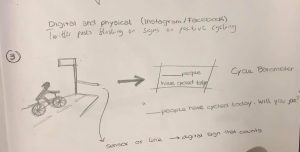
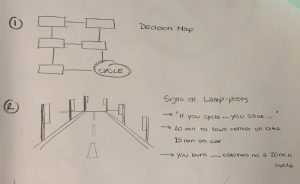
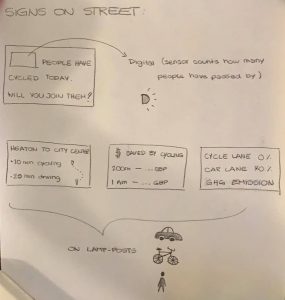
Our Feedback From our Mid-term Presentation
Along with our seminar work we also completed our midterm presentation this week. We felt like this went okay and we got a lot of helpful feedback. From this feedback we realise we should do some more research into all aspects of our project, including other projects like ours from which we can get more inspiration, bus timetables and routes so we can supply the knowledge of other alternative transport methods to driving and needing to park along Heaton Road. We want to include more pictures from our site visit and our meeting with Julie and Mark, this wasn’t asked of us but came from our own personal reflection on the presentation. One final point given to us was to think about where we will display our signs.
SIA Week 5 Log
This week we researched further into digital solutions for public engagement and we found some examples which deal primarily with engaging public opinion on a local level. From our seminar work we found the example ‘Viewpoint’, which is a digital interface that allows residents to vote and submit their opinion on local matters. The original Viewpoint technology was developed as part of the Bespoke project and it allowed local councillors and community organisers to ask simple questions with binary answers. A concept like viewpoint would reduce the time needed to complete door-to-door surveys. It would also remove the unpredictability of uncertainty, as we found out, door-to-door are not always successful. Cons of the product however, include the loss of the personal face to face conversation that community thrives on, the lack of explanation or elaboration of peoples’ opinion.
The Viewpoint example can be seen at: https://blackboard.ncl.ac.uk/bbcswebdav/pid-3867159-dt-content-rid-13421720_1/courses/K1819-TCP2031/Reflections%20on%20Deploying%20Distributed%20Consultation%20Technologies%20with%20Community%20Organisations.pdf
We hope to continue looking for more examples in the following days.
We also finalised our user research tasks and performed door-to-door surveys around the streets of Wingrove with one of our project partners, Katrina, the Greening Wingrove CIC Community Organiser. Whilst surveying local residents we also took this opportunity to interview Katrina about her personal thoughts on the area and the aims for the Arthurs Hill building. She spoke passionately about the need of more activities for the youth, ranging from toddlers to teenagers, and about the interconnection and potential link the building could have with other community facilities within the area, such as Nunsmore park.
From our door to door survey we obtained 20 responses. Of the people who answered the door their opinions seemed to echo Katrina’s in their vision for a thriving youth programme within the area. Below are the questions we asked and the most common responses we received:
What activities or events usually take place in this area? This question received various responses including Greening Wingrove events, Nunsmore litter picking, community groups and parties. However, of the 20 responses, 10 said that they did not know of any.
What are the changes Arthur Hill should make to become more socially environmental? The most common response was creating or finding things for the youth to do, such as having kid’s clubs. There was also mention of waste management, a community centre and a social media platform for communication.
How do you feel about interaction within the area? (Ranked 1-5, 1 = poor, 5 = good) Out of the 20 responses, the average response given was 2.7, which is a fairly poor response. Not a single person gave a 5 response and 1 was given four times.
How close are you with your neighbours? (Ranked 1-5, 1 = poor, 5 = good) Out of the 20 responses, the average response given was 2.6, which is also a poor response. From this question and the one before it is clear that there is room for improving social interaction in the area.
Do you wish to improve your interaction with your neighbours? (Yes or No) 13 respondents said that they would want to improve interaction with their neighbours.
Do you think a digital platform would help with this? (Yes or No) 15 respondents said that they believed a digital platform would help with improving interaction in the area.
What is your experience of using local facilities? (Ranked 1-5, 1 = poor, 5 = good) The average response received here was 2.9, so just below a satisfied response. Again this proves there is room for improvement.
What local facilities do you often use? This question received a wide range of responses including restaurants, church, cafes, Time Centre, transport, shops and supermarkets. However, the most frequent response was green spaces and parks.
How often do you use existing local facilities in a week? From the responses, the average response was 2.4 times a week. The most common response was once a week.
Do you use existing social platforms (such as Facebook groups) regularly? (Yes or No) Only 10 of the 20 respondents said they use existing social platforms regularly.
What do you use these social platforms for? Of those that said they used the social platforms, entertainment and news were the most common response. Arranging meetings and reporting issues were the other responses given.
Whilst surveying door-to-door, we did come to the realisation that this method is not as successful as pre-arranged interviews or meetings, it is a long process with little outcome. We felt that for the most part, a digital solution could be a highly effective potential going forward, taking inspiration from the Viewpoint boxes, which we found in our example search. From this, our digital design could be focused on gaining a broad and ranged opinion from a digital polling system. Whether this could perhaps be an interface inside/outside the building or in local shops/cafes is something we would have to discuss further.
Another idea that came from the user research was potentially creating a digital interface for the youth of the area to connect with the building, and the area, as we learnt of the hardships of many of the families within the area. It could potentially be worth-while to create an interface for the youth of the area, as many come from disenfranchised homes, some even being crammed into a house with 5 or 6 families, as we learnt from Katrina.
Our next steps for the project is to begin mapping out and sketching our digital interaction solution. Bringing together both our example search and user research to create the best solution for public engagement and interaction within the Wingrove area.
SIA Week 4 Log
Week 4 Log
This is the week 4 log for SIA. This week we carried out part of our user research, meeting with various project partners and also began searching for examples of products/services/devices that serve as state of the art in our project.
User Research:
As part of our user research we went to the Greening Wingrove Annual Meeting on the 16th February. We felt as though this meeting would give us a huge opportunity to meet some of our project partners and potentially even meet some local residents in the area. The event was also useful as it took place at 250 Philip Street, Arthur’s Hill (the building that part of our project is based on) and so we got a much better idea of the actual building we were working with.
At the meeting, we spoke with David Webb, who is a local resident and the Secretary of Greening Wingrove CIC as well as one of our key stakeholders in the project. Below are the most important and valuable points we obtained from the interview with David:
- Currently local residents communicate through WhatsApp groups and Facebook pages. The WhatsApp groups are used to contribute ideas and thoughts, but are rarely used, with David mentioning that ‘messages are transferred maybe once every two weeks’. The Facebook groups are slightly more active. However, the problem is that there are many different pages and so trying to organise larger events or communicate on a large scale is difficult.
- The main issue David said we would have with our project is that not everyone will use one form of social network, which on one of the reasons multiple platforms are currently used.
- David’s vision for the building involved using it for multiple purposes. Ideas included a post office, renting out the top rooms for storage, use of the already in place music studio and events for the youth including youth clubs and weekly activities.
We also managed to speak with other members of Greening Wingrove with the main points from them being:
- Not enough is available for younger generations to do, with many just roaming and playing on the streets.
- There is a difficulty in getting all the locals involved in the area. This is primarily due to language barriers and people not knowing what events are out there.
We aim to continue with our user research in the following weeks with our door to door surveys. We are also hoping to organise an interview with Katrina Jordison, the Greening Wingrove CIC Community Organiser, as we were not able to speak to her for too long at the annual meeting.
Week 5 Log – NUTC
LOG WEEK 5
This week we met with one of the academic partners that mentors us, Tom Maskell (PhD student in Open Lab) who happens to have a background in walking and cycling connections for the community. He introduced us to the newcastle walking cycling routes website in which he participated in the creation of. This website was able to show us the main concerns by the general public and where these were located on a map. This is mainly coming from walking and cycling advocates – most comments are green so they believe it is very important, the red and yellow are less important. ( which suggests there are not many drivers as there aren’t many red and yellow.)
https://newcastlewalkingcyclingroutes.commonplace.is/comments/5beefcc45a173b000e05ac22
Our group discussion with our mentor led us to review our project aims as we currently didn’t have a main focus. Tom helped us to understand the best way to use our projects user research and the examples that inspired us to get to the point we are at. He also made us realise that we should do something interactive along Heaton Road that could be seen either by cyclists and pedestrians or drivers.
The Ladder of Participation
Tom reminded us of The Ladder of Participation which we had heard of before but had forgotten about. He explained to us it’s very important to think about our approach to the project and to use this ladder to determine if we wanted more of a manipulative method of making the public more accustomed to the cycle route or if we wanted to be more informing and consult the public more on what they wanted.

Our Best Approach
After an intense group discussion we figured that our best approach should be a more persuasive one, closer to the middle/bottom of the scale, in which we could try to persuade the people sat on the fence or were fully opposed to the cycle route. We came to the conclusion the project is at its final stages of being given the go ahead, with one big final consultation happening in early May and then just the legal processes to be completed, so collecting people’s opinions wouldn’t be as relevant to just trying to change those of the opposed, as the project is shortlisted and one of the councils favourites to happen.
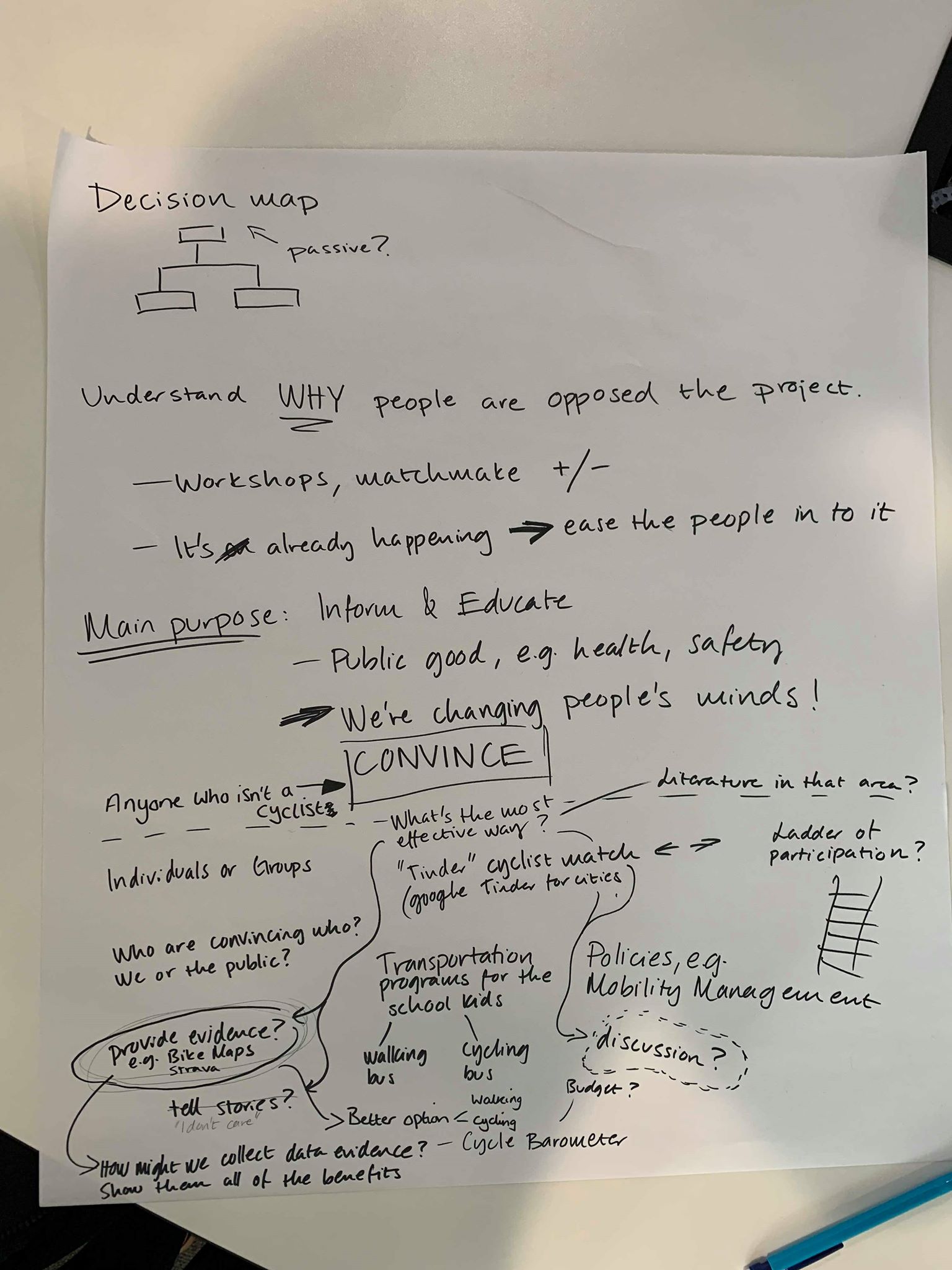
Process
After deciding our main purpose we came up with many different questions of how to actually get across our aim to the public. These questions can be seen in the picture below in which some of our main questions were :
- who’s trying to convince who? Us or the public?
- Will we try to target individuals or groups?
- Would we want to use data/prove, discussions or tell stories to convince people?
In the end we decided our main target would be finding the correct data to answer the question ‘how can people benefit?’ as this would motivate them to change their opinions. We think people would be led by the reduction in costs, health benefits, the advancement in helping the planet (Carbon Footprint reduction), making Heaton a safer environment and if they knew other transport methods were available and easier to use they may be swayed by that.
Conclusion
We have been trying to come up with as many ideas as possible ready for next week in which we are to begin sketching our final project ideas. We still like the idea of a form of an interactive decision map or signs along Heaton Road with phases that show people the benefits of cycling, and we also like the sound of the Cycle Barometers in which Tom introduced us to.
Although the last one may be too much of an expensive method and more focused on the cyclists and not the people who are opposed who’s minds we are trying to change. We are hoping to have made our mind up on this ready for our next lecture.
Week 4 – Chase Park
This week we progressed further on our workshop we are doing with the children at Front Street Primary School Whickham. We have drawn up an outline plan of the activities we will complete with the children at the school. The current plan needs some tweaking and we discussed how an additional activity of how they would show other people about the park which we have added to the original plan. Hopefully we will get some creative ideas on how they would use video/technology to help them to this.
So far our plan is:
(0 min) Introduce ourselves and why we are there.
(5 min): Starter:
Get the teachers to organise children into groups of around 4-6, depending on class size.
Each group of children are to draw the outline of chase park, giving them A3 sheets with colouring pens and pencils.
* Use photographs as visual stimuli
* Ask them – what can you remember about the park? What is there? Where do you like going in the park? What do you like to do there?
* Remind them – Doesn’t have to be a work of art or very accurate etc
(20 min) Activity 2: Groups to decide between themselves what places in the park are the best to them, giving them stickers such as golden stars to stick on their drawings.
* Use star stickers, emoji stickers (Sean can bring these)
* Can also layer the map with post it notes, pens and stickers (Sean can bring these)
(30 min) (Class discussion)
Going around each group and getting them to say one of the places they highlighted and why.
(35 min) Activity 3: Giving them another set of colours, get them to draw on where and what they would want in their park. What would make them use it more.
* Describe how you would make the park better for people to come and visit
* Bring your ideas to life!
Write down possible ideas for activities that could be done in the park too.
(1hr 0 min) (Class discussion)
What were the best ideas of each group when they thought about improving or adding something new to the park.
* Write on flipchart paper
(1 hr 05 min) Activity 4:
How would they show / tell other people about the park? How would you get the message out about the great things that are in the park? Work in groups to come up with some ideas.
* Posters?
* Technology?
* Videos?
* News reports?
(1 hr 25 min) Class discussion and feedback.
(1 hr 30 min) Finish.
It still requires a bit more attention to detail before we deliver the workshop at the school but the general activities and timings are in place. Unlike a normal school activity, we want the workshop to provide us with information from the children rather than the other way around. We hope that the children will really enjoy having the opportunity to share their ideas to us, however creative or crazy they might be.
We are also currently organising a convenient time to meet Holly from ‘Kick the Dust’ and preparing some questions for her. Jen suggested we look to ask similar questions to what we will ask the children but phrase them in a more suitable way.
We have done some example searches, one of which was BlockBuilders (https://blockbuilders.co.uk). BlockBuilders use Minecraft to engage with younger children in planning and designing places. One positive would be that whilst children are engaging in planning and design of their communities they feel as though they are just playing, and it is made to be fun. If it is fun they are more like to enjoy it and be engaged with the product for longer. This was a good example as it specifically focuses on young people. A criticism for BlockBuilders is that it is only accessible via a Workshop from Brighton with limited spaces, and therefore it is currently inaccessible for most young children.
We recognise we have not completed enough useful example searches and are still doing research on example searches to help us develop our own concept.
Week 4 Log – NUTC – Example search
Log week 4
This week we followed up on our idea of taking a site visit to Heaton Road here we managed to talk to a few of the locals and gather some ideas of how they felt about the project. Most of them seemed to be happy with the idea of a cycle lane although these people claimed to be cyclists themselves so it coincides with the data we found on the website ‘streets for people’ (51% wanted segregated cycle lanes). A couple of the people we spoke to said they were drivers of cars and would struggle with the addition of a cycle lane, due to the lack of parking spaces that would become a reality once the lane was installed.
Our Inspirations
This research was inspired by a project we found in the Netherlands about How to turn a Car city into a Cycling city*. As most of the cities (both in this project and in general) were planned and designed for the car, the first thing that had to be done was “appeasing the motorists instead of encouraging cyclists”. As we have written before, Heaton Road is very “car-occupied”, which makes this reference project very relevant to our own project. It has inspired us to do more further research into their ideas and how ours could relate seen as they were successful.
We also found this article** useful which was suggested to us by Sean. After reading through it we understood more about the concept of a “smart city” and how GPS, as well as other GIS tools, could be used to track the main cycle routes within an area. We were then also able to recognise the divide between the East and West were the West had hardly any cycle routes in comparison potentially down to the development of transportation and wealth of the area.
We spoke during the lecture about how negative comments would impact us and the project, and we have decided that negative comments would be our main target and we would focus on understanding them more and persuading the people to change their opinion. This is now one of our main project goals, alongside meeting the needs of the briefing given by Ali and creating a interactive/inclusive platform.
Our Concept
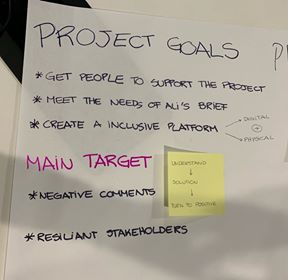
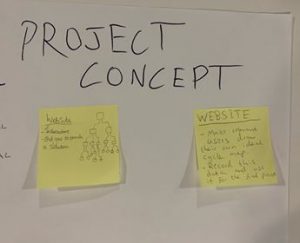
We also began to come up with a concept for our project although we feel that we will be able to adapt this more after talking to the other project partners (Mark and Julie). One of the concepts was the idea of getting cyclists to map their ideal route and recording this information, then putting it into a map of sorts to show how useful the cycle route would be by connecting Heaton Road to other/ smaller cycle paths. The other concept was a interactive Decision Tree, we would make several questions which would have multiple answers provided already to choose from, leading to more questions, eventually ending up with one final answer, which would be an end goal of the cycle route being the best option for all users. This would be an online concept but we would also be able to make it as an interactive poster for people without access to the internet.
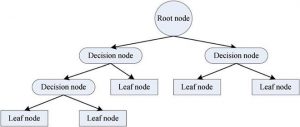
This is an example of the format of a Decision Tree, although we believe ours would be larger. The “leaf nodes” would be one final answer for the participants.
Next week we are planning to visit Heaton Road again and to interview some of the stakeholders to get a wider range of views on the project and hopefully to begin to build upon our concept idea. We are also meeting the project mentor so hopefully we will gain some insight into their thoughts on the project and some much needed experience in the area. We also have our meeting with Mark and Julie arranged although due to unforeseen circumstances this has been set back slightly.
References
*Link to reference project: https://nextcity.org/features/view/how-to-turn-a-car-town-into-a-cycling-city?fbclid=IwAR1ckGS1GZ-tyq5lrf_wh3yy4qd2owdLhLYOgG5topXSbMKYfzJ3AWH0ZMY [Online: Accessed 19-02-2019]
**Link to article:
https://ledantec.net/wp-content/uploads/2014/09/Le-Dantec-Planning-with-Crowdsourced-Data-CSCW15.pdf?fbclid=IwAR3FHHvqkw5f5ue3geihm0nwpHWlHdQmQyg-B_AhsobTz_BtbLac7kzeLQg [Online: Accessed 19-02-2019]
4) TRECC Review and Project inspirations
This week we made a lot of advancements from the previous week as we felt we couldn’t really move forward without meeting our mentor. When we met with Peter he guided us on power dynamics as something major we need to consider- do community feel safe expressing their views to a large, intimidating company? Will their voices be heard? Will their views and opinions be twisted? David also expressed concerns over transparency- how much will be released to the public? Will anything be held from public? Regarding the app he suggested a few things for us to consider:
- A reference/scrutiny group to sign things off from developers before posting on the site and approve comments from residents before they go live
- Is it possible to have a framework? Each development is different
- Developers digitised proposals make it easy for them to gloss over more difficult/controversial parts of the scheme- we need to be aware of that and keep up level of transparency
- Always going to be controversy and challenge around new developments- has potential to cause more dispute
- WHO IS YOUR AUDIENCE?
From the meeting and time spent as a group we had began to perfect our ideas and think more in depth about the exact features of our app. Another main point is the we had previously been calling the group of people we wanted to engage with ‘hard to reach’ and from our mid term presentation it was pointed out that how could we engage with all these different groups of people with one app when they all have different needs. We came to the decision that we would be focusing our app on the groups of people that already show an interest in planning but due to current procedures they cannot express how they feel. Now our aim was to focus on people that wanted to engage but couldn’t rather than get more people engaged because you can’t really engage someone if they don’t want to be engaged. From this we had a clear focus and could begin to start thinking of how we would design our app.
Atlanta Community Engagement Playbook:
Inspirations for the app came from literature and ideas around the world and we could really start to get specific in what we wanted. One very helpful literature was about the Atlanta Community Engagement PlayBook which is designed for Atlanta one of the fastest growing cities in USA to engage communities to facilitate constructive engagement and to mobilise community-led development and change. The long-term goal is to offer community associates and service providers a set of actionable practices to achieve greater levels of quality engagement. We selected this as one of our main inspirations as we would be associated more closely with being a ‘service provider’, but some of the principles behind the plays for community associations are what we are trying to include within the app (e.g. creating a community led vision for change; creating an inviting and open platform for community members to rally around; and weaving elements of fun and culture the practice). The long-term goals of the playbook is similar to our long-term goal as we want to create a tool that will actually alter the current practices, however we are going down the route of the app rather than more community based projects. This makes it easier for us to involve all the members of the community that wish to be involved. Some of the action guides provide useful methods for some practices, we have used, and could still use, some of these guides when going through the processes of mapping, sketching, deciding, prototyping, and testing.
Playing with Empathy: Digital Role-playing games in Public Meetings
This literature was a study of the implementation of a game called participatory Chinatown a 3D multiplayer game designed to be played in the physical space of planning meeting in Bostons Chinatown neighbourhood. The reading helped us to understand how role-play can affect the way people understand issues and engage and looks at challenges of extracting player empathy from gameplay to a larger context that can then be studied and implemented. Some features include augmented deliberation like debating while playing as character in 3D virtual world (not necessarily as themselves) enchancing empathy, which is needed for group cooperation. There were high scores at the end for discussion where the discussion moderator asks people (using characters name) on how they felt about results this prompted discussion about competition, trade-off, lack of resources, transportation. Participatory Chinatown demonstrates that role-play can engage players in local issues and motivate engagement. However its making people aware of how the framework acts outside the game when you cannot score points. We used some extractions from this document rather than the framework of the game. Our target audience is not people that have a lot of time on their hands and would not really engage in something that required so much effort as going somewhere and walking around. However from this we learnt that the whole idea of visually seeing something and being able to walk around it and see all elements really helped with engagement. From this we started to develop ideas about a map feature in our app that would allow users to physically see the development locations and scroll around to see exact details. Also the importance of the discussion aspect, in our app rather than promote a huge conversation between everyone which could go off topic we are thinking about more of a news feed of everyone different comments so everyone feels their voices are heard.
Second life:
This idea is advanced logging (collection of data) techniques to capture the interactions of the user with the virtual environment to generate a log i.e. what people look for in a CAD imagine or where they go in a game. This is then brought together to create an approximate estimation of real user interaction with the project in real life. It can produce design ideas and amendments from planners and users of the programme. Second Life gives a running account of user experience with the project as it starts and moves on, giving planners better and more comprehensive ideas for the use of space. Second Life puts users in a virtual world in the place of an avatar or a playable character, users walk through and interact with the space and the objects within it. Users can see how the new development will look or show how they interacted with the old site and information is collected from both. We took a lot of inspiration for this as it really showed that ICT is becoming ever more vital for urban planning in 21st century but there is some worry about more local communities being overlooked in favour of more global and further reaching initiatives so we realised the importance of focusing on the local. From this we decided to make everything user specific so that the community felt that this application had been made for them and tailored to there needs which we had gathered from our stakeholder meetings. But also heavily featured these ICT features that are fairly new and we new we wanted the make something modern and innovative. It showed us that to visualise it there needs to be a feature of the virtual environment we have continually seen pop up to stay with the times.
We look forward to start defining and perfecting our ideas.
4) Youth Council group – example search
Digital Civics blog
During last week’s session it became clear that we had one main design concept in mind – a website with an interactive tool to address litter as a social problem. Originally we were going to design our interactive tool in an app, however it became clear that it could be too costly and therefore decided to do it via a website. The website also fits in well with the feedback that we got from the youth council as they said it would be a good idea to put the website link on the school home page, which in turn should generate a larger user group as more young people will be coming across our page on a daily basis and get to a large young audience as we are targeting schools.
The design of the interactive tool itself revolves around being able to go through the North Tyneside area with your mouse on the computer screen. From here young people will be able to gain more of a perspective of where litter ends up i.e. landfill, the ocean etc. There will also be a game that almost takes inspiration off Pokémon go where you can collect points from barcodes off bins and in turn get rewards when you pick up rubbish (this is an minimally developed idea and we are looking into the logistics of it more). We are also hoping to design a ‘North Tyneside of the future’ which will give an outlook on how the area will look if we continue to litter at such a rate, and on the other hand how it would look if we were to become cleaner- we hope that this could encourage behavioural change that will change their outlook on how to treat their local area. Below are a couple of links to show the sort of style we want our website to follow.
https://www.youtube.com/watch?v=Ur9MqboHfhw
https://www.youtube.com/watch?v=v64KOxKVLVg
Although we have a relatively clear idea in mind, we are still yet to get much feedback off the client, and because of this we have been in contact to ask a range of question. Although we are still waiting on a reply we hope that once we get these answers we will be able to shape exactly the direction that our project is going. In addition to this we received feedback during our presentation that it would perhaps be in our interest to look at a wider range of environmental issues which prompted us to think of the possibility of a quiz on the same webpage that young people can fill out, this data can then be collected and returned to the schools – this can then get passed to the youth council who can use this information to benefit them when putting forward ideas to change the area and express young people’s point of view in a more professional manner.
4) Cycle stakeholder forum
After the first meeting with Rob Snowball, we established some specific goals that we reached after interviewing our stakeholders, Rob Snowball, Heather Evans, Rorie Parsons and Mark Nelson. Regarding or long term goals, they haven’t really changed, they are just more precise. We still want to get more involved in the forum, a feeling shared by most of the people we met but our main goal will be to focus on how to make this forum progress.
This idea is divided in two points :
- First, we need to improve the visibility of the forum, especially on the website which is not very visible. But also help cycling to get a better recognition in the city.
- Secondly, to make access to the feedback easier for all the people who attend the forum and also easier to publish it, after Heather has taken the minutes.
Furthermore, we find it useful to improve interactions between the council and the forum.
Products/services/devices that serve as inspiration for our project
Mobile Phone: We chose this piece of technology as it can be accessed by a wide range of individuals due to the popularity of smartphones and the fact that individuals can access information anywhere anytime. In our project it is important that we have a system that can communicate information clearly and can be accessed by a wide demographic of individuals in the forum, we think a mobile phone could meet this criteria.
Computer: We chose this device as it is one of the most effective ways of communicating information between individuals however this device is more accessible by the older generation. This is important as a large portion of the cycle stakeholder forum are of the older generation that might have more access to computers than mobile phones.
Email: Email was recommended to us as a good transfer and display of information by Mark Nelson as a way to communicate the time of meetings and also to supply the meeting notes to a group of individuals. Email newsletters are also simple to setup and use.
Website: A website is an accessible way to present and relay information. They can also be interactive which is important for the cycle stakeholder forum as we need a system in which people can communicate their opinions on different cycle routes around Newcastle.